
Astragalus alpinus is a species of flowering plant in the legume family known by the common name alpine milkvetch. It has a circumpolar distribution, occurring throughout the upper latitudes of the Northern Hemisphere.

Sabulina rubella is a species of flowering plant in the family Caryophyllaceae known by several common names, including beautiful sandwort, mountain sandwort, Arctic sandwort, and boreal stitchwort. It has a circumboreal distribution, occurring throughout the northernmost Northern Hemisphere from the Arctic Circle on the Arctic tundra into the alpine climates of mountainous areas in temperate Eurasia and North America. It grows in rocky, moist, often barren habitat, including gravelly, sparsely vegetated slopes with little organic matter. It is a calciphile, growing in calcareous substrates such as soils rich in decomposed limestone.

Solidago multiradiata is a species of goldenrod known by the common names Rocky Mountain goldenrod, northern goldenrod, and alpine goldenrod. It is native to North America, where it can be found throughout the northern regions, including Alaska and most of Canada (all 3 territories plus all provinces except Prince Edward Island, including territory north of the Arctic Circle. Its distribution extends through the western United States as far south as Arizona, New Mexico, and California. It is known mostly from the subalpine and alpine climates of high mountain ranges. Its habitat includes tundra and mountain meadows.

Galearis rotundifolia is a species of flowering plants in the orchid family, Orchidaceae. It is commonly called roundleaf orchid and small round-leaved orchid. It is a succulent perennial herb native to North America, where it occurs throughout Canada, part of the northern United States, and Greenland.
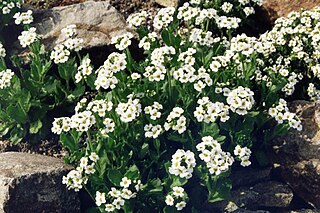
Draba fladnizensis is a species of plant in the family Brassicaceae known by the common names arctic draba, Austrian draba, and white arctic whitlow-grass. It has a circumpolar distribution, occurring throughout the northern latitudes of the Northern Hemisphere. It is present in Europe, Asia, and North America from Alaska across northern Canada to Greenland. Its distribution extends south through the higher elevations in the Rocky Mountains to Colorado and Utah. It is common and widespread in the Canadian Arctic Archipelago, occurring on several Arctic islands including Baffin, Devon, and Ellesmere Islands. It is named after the Austrian village of Flattnitz, in the Gurktaler Alpen.

Veratrum hybridum is a species of flowering plant in the Melanthiaceae known by the common names slender bunchflower and crisped bunchflower. Many publications use the synonyms Melanthium latifolium and Veratrum latifolium, but the "hybridum" epithet is 9 years older than the "latifolium," so Veratrum hybridum is now the accepted name.

Oxytropis podocarpa is a species of flowering plant in the legume family known by the common names stalkpod locoweed, stalked-pod crazyweed, and Gray's point-vetch. It is native to North America, where it occurs in the northern latitudes, from Yukon and British Columbia across the low arctic to northern Quebec and Labrador. In the Rocky Mountains it occurs at the higher elevations as far south as Colorado.

Ranunculus pedatifidus is a species of buttercup known by the common names surefoot buttercup, northern buttercup, and birdfoot buttercup. It has a circumpolar distribution, occurring throughout the northern latitudes of the Northern Hemisphere. There are two varieties, var. pedatifidus occurring mostly in Asia and var. affinis mostly native to North America.

Carex bigelowii is a species of sedge known by the common names Bigelow's sedge, Gwanmo sedge, and stiff sedge. It has an Arctic–alpine distribution in Eurasia and North America, and grows up to 50 centimetres (20 in) tall in a variety of habitats.
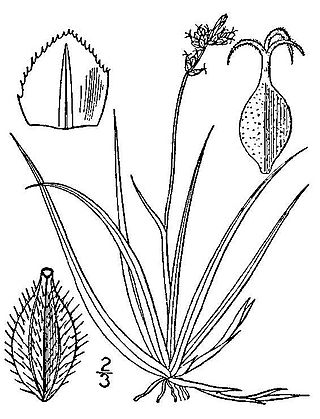
Carex concinna is a species of sedge known by the common names low northern sedge, northern elegant sedge, beauty sedge, and beautiful sedge. It is native to northern North America, where it occurs across Canada and in high elevations in the northern contiguous United States.
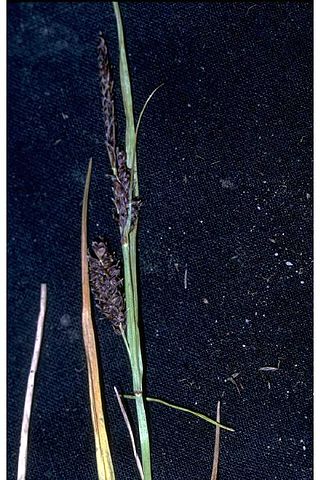
Carex saxatilis is a species of sedge known by the common names rock sedge and russet sedge.
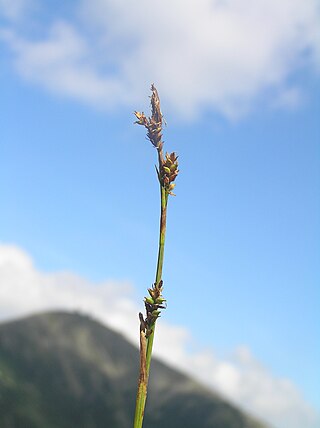
Carex vaginata is a species of sedge known by the common name sheathed sedge.

Carex simpliciuscula is a species of sedge known by the common names false sedge, simple bog sedge and simple kobresia. It has a circumpolar distribution, occurring throughout the northern latitudes of the Northern Hemisphere.
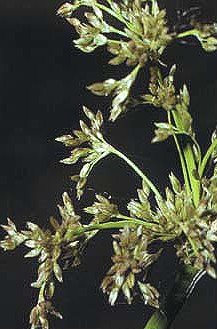
Juncus roemerianus is a species of flowering plant in the rush family known by the common names black rush, needlerush, and black needlerush. It is native to North America, where its main distribution lies along the coastline of the southeastern United States, including the Gulf Coast. It occurs from New Jersey to Texas, with outlying populations in Connecticut, New York, Mexico, and certain Caribbean islands.

Poa arida is a species of grass known by the common names plains bluegrass and prairie speargrass. It is native to North America, where it occurs throughout western and central Canada and the central United States. It is most common east of the Continental Divide; specimens west are often misidentifications.

Smilax laurifolia is a species of flowering plant in the greenbrier family known by the common names laurel greenbrier, laurelleaf greenbrier, bamboo vine, and blaspheme vine. It is native to the southeastern United States, where it occurs along the Gulf and Atlantic coastal plains from Texas to New Jersey, the range extending inland to Arkansas, Oklahoma, and Tennessee. It also occurs in Cuba and the Bahamas.

Vaccinium pallidum is a species of flowering plant in the heath family known by the common names hillside blueberry, Blue Ridge blueberry, late lowbush blueberry, and early lowbush blueberry. It is native to central Canada (Ontario) and the central and eastern United States plus the Ozarks of Missouri, Arkansas, southeastern Kansas and eastern Oklahoma.

Juncus luciensis is a species of rush known by the common name Santa Lucia dwarf rush. It is endemic to California, where it is uncommon.

Oreojuncus trifidus is a species of rush known by the common names highland rush and three-leaved rush. It is native to the Northern Hemisphere, where it is an arctic/montane species with an amphi-atlantic distribution.

Eriophorum scheuchzeri is a species of flowering plant in the sedge family known by the common names Scheuchzer's cottongrass and white cottongrass. It has an arctic circumpolar and circumboreal distribution in the Northern Hemisphere. It can be found in Alaska, across Canada, in the Arctic islands, Greenland, Iceland, and across Eurasia. Disjunct occurrences exist in the Rocky Mountains, in the high mountains of southern Europe and on Mount Daisetsu in Japan and some other Asian mountains.





















